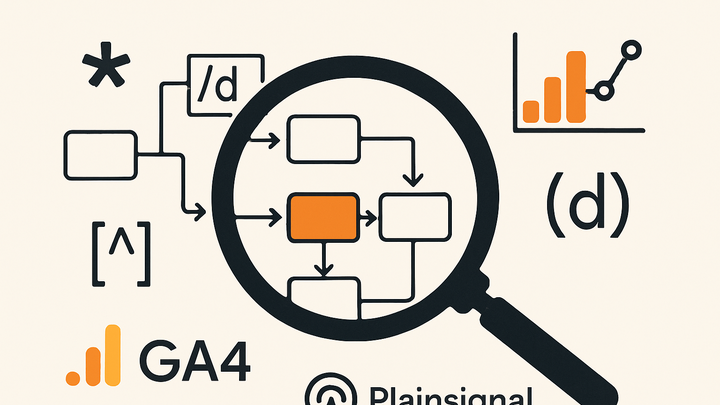Published on 2025-06-28T02:23:42Z
What is Pattern Matching in Analytics? Examples & Use Cases
Pattern matching in analytics refers to the process of identifying and extracting recurring sequences or regularities within user behavior and event data. It empowers analysts to define rules—often using regular expressions or sequence templates—to detect specific flows such as page_view > add_to_cart > purchase, filter URLs, or group similar user journeys. By leveraging pattern matching in tools like Google Analytics 4 (GA4) and PlainSignal, teams can automate complex segmentation, build precise audiences, and uncover anomalies without manual tagging. This technique enables deeper insights into conversion funnels, anomaly detection, and user segmentation at scale. Pattern matching streamlines data analysis by allowing for dynamic rule definitions that adapt to evolving website structures and user behaviors. With accurate patterns, businesses can increase personalization, improve marketing effectiveness, and optimize user experience. Understanding and implementing pattern matching is essential for modern analytics strategies.
Pattern matching
Extract sequences in user behavior data for segmentation, funnel analysis, and anomaly detection using regex and sequence rules.
Why Pattern Matching Matters
Pattern matching enables analysts to detect meaningful sequences and trends in large volumes of user data, automate segmentation, and uncover insights that manual inspection might miss.
-
Behavioral insights
Detect specific user flows—like signup to purchase—to optimize conversion funnels and personalize experiences.
-
Conversion funnels
Match event sequences such as page_view > add_to_cart > purchase to analyze drop-offs.
-
Churn indicators
Identify patterns like repeated login failures or session timeouts that signal potential churn.
-
-
Anomaly detection
Flag unusual traffic patterns or event spikes/drops to proactively address performance or usability issues.
-
Traffic spikes
Detect sudden increases in pageviews or sessions that may indicate a viral event.
-
Error trends
Monitor patterns of error or exception events to prioritize debugging efforts.
-
Common Pattern Matching Techniques
There are several techniques to implement pattern matching in analytics, each suited to different use cases and data types.
-
Regular expressions
Use regex to match URL patterns, event names, or parameter values with wildcards, quantifiers, and character classes.
-
Url filters
Filter page URLs that match a domain or path structure, such as ^/products/[0-9]+/details$.
-
-
Sequence analysis
Analyze ordered lists of events to understand typical user journeys and predict next actions.
-
Markov models
Estimate the probability of moving from one event to the next for predictive analytics.
-
-
Path grouping
Group similar user paths by replacing dynamic segments with placeholders.
Pattern Matching in SaaS Analytics Tools
Popular analytics platforms like PlainSignal and GA4 offer built-in pattern matching capabilities for filtering, segmentation, and event definition.
-
PlainSignal
A cookie-free analytics tool that uses simple pattern rules to group events and filter URLs without storing personal data.
-
Setup snippet
Include the PlainSignal tracking code and define URL or event patterns in its dashboard.
-
-
Google analytics 4 (GA4)
GA4 supports regex-based filters in event configurations, custom dimensions, and audience definitions.
-
Event parameter filters
Apply regex patterns to event parameters to include or exclude data.
-
Audience builder
Create audiences by matching sequences of events with AND/OR logic and pattern rules.
-
Implementing Pattern Matching
Follow these steps to define and apply pattern matching in your analytics setup.
-
Define patterns
Map out the event sequences or URL structures you want to track before writing expressions.
-
Behavior mapping
Document key events and their order in a user flow.
-
Regex drafting
Draft regex patterns to match event names or URL paths.
-
-
Apply in tracking code
Embed your analytics snippet and verify that pattern rules correctly capture data.
<link rel="preconnect" href="//eu.plainsignal.com/" crossorigin /> <script defer data-do="yourwebsitedomain.com" data-id="0GQV1xmtzQQ" data-api="//eu.plainsignal.com" src="//cdn.plainsignal.com/plainsignal-min.js"></script>
